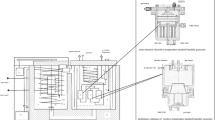An inexpensive adsorption humidistat working in the static and dynamic regimes is proposed. This humidistat is designed for maintenance of the relative humidity and temperature in a closed space at levels (15–18%, 20–25°C) necessary for reliable storage of rare books, manuscripts, pictures, and museum valuables and for their safe transportation in the process of visiting exhibitions. Principles of maintenance of the relative humidity in a closed space with the use of chemical substances and autonomous thermostatting of this space are considered. Results of testing of some new moisture buffers under laboratory and real conditions are presented.
Similar content being viewed by others
References
Storage of Works of Art in Museums, Practical Texbook [in Russian], GosNIIR, Moscow (1995).
G. Tomphson, The Museum Environment, Butterworths, London–Boston (1986).
N. Stolow, Conservation and Exhibitions (Packing, Transport, Storage and Environmental Considerations), Butterworths, London–Boston (1991).
D. S. Carr and B. L. Harris, Solution for maintaining constant relative humidity, Ind. Eng. Chem., 41, No. 8, 2014–2015 (1949).
I. S. Glaznev, I. V. Salnikova, V. N. Alekseev, et al., A new humidity buffer for showcases, Stud. Conserv., 54, 133–148 (2009).
Yu. I. Aristov, I. S. Glaznev, V. N. Alekseev, et al., ARTIC: A new humidity buffer for showcases, in: P. Engel (Ed.), Research in Book and Paper Conservation in Europe — a State of the Art, Impressum @ Verlag Berger, Horn/Wien, ISBN: 978-3-85028-490-5, pp. 207–240 (2009).
A. E. Sheindlin, New Power Engineering [in Russian], Nauka, Moscow (1987).
O. V. Dikhtievskii, G. V. Konyukhov, O. G. Martynenko, and I. F. Yurevich, Numerical modeling of an optimal heat accumulator with phase change, Inzh.-Fiz. Zh., 61, No. 5, 749–755 (1991).
M. Hamdan and F. Elwerr, Thermal energy storage using a phase change material, Solar Energy, 56, No. 2, 183–189 (1996).
L. L. Vasiliev, V. S. Burak, A. G. Kulakov, et al., Heat storage device for preheating of the internal combustion engine for starting, Int. J. Therm. Sci., 38, 98–104 (1999).
L. L. Vasiliev, V. S. Burak, A. G. Kulakov, et al., Latent heat storage modules for preheating internal combustion engines: application to a bus petrol engine, Appl. Therm. Eng., 20, 913–923 (2000).
L. L. Vasiliev, M. I. Rabetskii, and V. G. Kiselev, Heat-transfer device for heating of extended horizontal objects, Inzh.-Fiz. Zh., 52, No. 1, 62–66 (1986).
M. I. Rabetskii, Vapor-Dynamic Thermosyphons, Preprint No. 11 of the Heat and Mass Transfer Institute, Academy of Sciences of BSSR, Minsk (1988).
P. D. Dunn and D. A. Reay, Heat Pipes, Pergamon Press (1994).
B. Palm, Hydrocarbons as refrigerants in small heat pump and refrigeration systems: review, Int. J. Refrig., 32, 552–563 (2008).
S. W. Chi, Heat Pipes [Russian translation], Mashinostroenie, Moscow (1981).
L. L. Vasiliev, A. S. Zhuravlyov, M. N. Novikov, and L. L. Vasiliev Jr., Heat transfer with propane evaporation from a porous wick of heat pipe, J. Porous Media, No. 4 (2), 103–111 (2001).
L. Vasiliev, A. Zhuravlyov, A. Shapovalov, and V. Litvinenko, Vaporization heat transfer in porous wicks of evaporators, Arch. Thermodyn., 25, No. 3, 47–59 (2004).
L. Vasiliev, A. S. Zhuravlyov, and A. Shapovalov, Heat transfer enhancement in minichannels with micronanoparticles deposited on a heat-loaded wall, J. Enhanced Heat Transfer, 19, No. 1, 13–24 (2012).
L. I. Roizen, D. G. Rachitskii, I. R. Rubin, et al., Heat transfer in boiling of nitrogen and Freon-113 on porous metal coatings, Teplofiz. Vys. Temp., 20, No. 2, 304–310 (1982).
K. Nishikawa and T. Ito, Augmentation of nucleate boiling heat transfer by prepared surfaces, in: Heat Transfer in Energy Problems, Hemisphere, Washington: D.C. (1982), pp. 111–118.
R. F. Webb, Nucleate boiling on porous coated surfaces, Heat Transfer Eng., 4, Nos. 3–4, 71–82 (1983).
Author information
Authors and Affiliations
Corresponding author
Additional information
Translated from Inzhenerno-Fizicheskii Zhurnal, Vol. 85, No. 5, pp. 899–908, September–October.
Rights and permissions
About this article
Cite this article
Aristov, Y.I., Vasiliev, L.L., Glaznev, I.S. et al. Physicochemical bases of autonomous maintenance of humidity and temperature in closed spaces. J Eng Phys Thermophy 85, 977–986 (2012). https://doi.org/10.1007/s10891-012-0737-3
Received:
Published:
Issue Date:
DOI: https://doi.org/10.1007/s10891-012-0737-3




